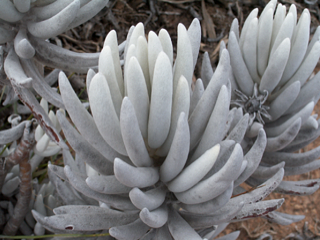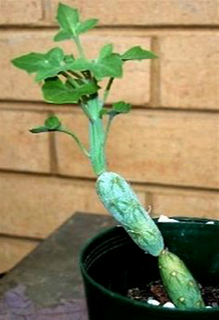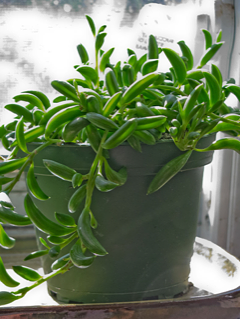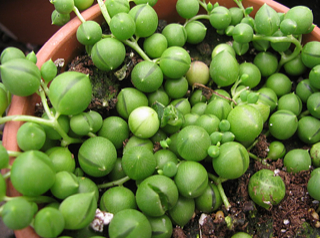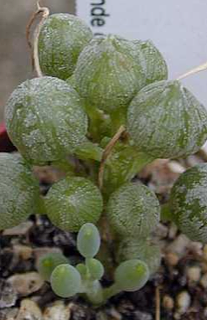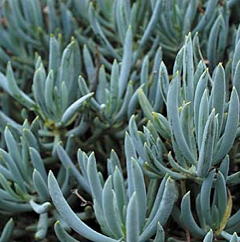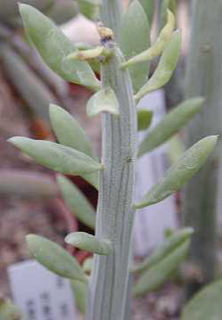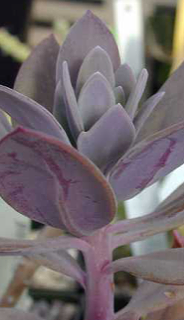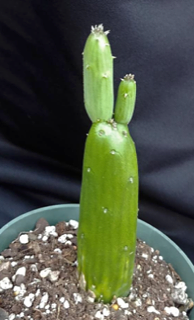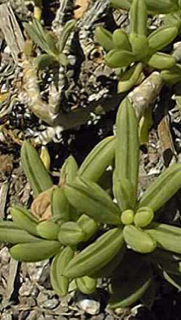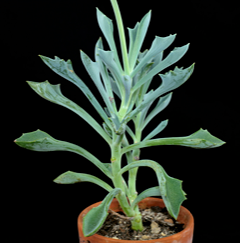Submitted by: Jim Tanner and Maria Capaldo
DNA research has come up with some changes in the Senecio taxonomy and so some of the succulent plants previously designated as Senecio have been split into the following genera: Caputia, Curio, Kleinia, and Senecio. They are all members of the family Asteraceae. In general, all four genera are very drought and heat tolerant and not very cold tolerant. They grow best in full sun. A few species can tolerate brief periods of cold or dampness, but prolonged exposure will turn them to mush.
The leaves are thick and fleshy and can be deep green, bluish or even striped. The leaves of these succulents vary widely in shape. Some are round, some banana-shaped, some stand upright. The flowers form in clusters, on long stems. Different species bloom at different times throughout the year. The flowers persist for weeks. Shapes include red or white spires and yellow daisy-like flowers, but it is really the foliage that interests most gardeners. Many of their species are toxic to animals and humans if ingested.
Most plants of these genera are low growing, under 1 ft. tall. Depending on genera, they may spread out and be used as groundcover or trail down about 1 ft. or more.
Caputia: Usually those with a hairy coating on the white leaves. These include:
- Caputia oribiensis (=Senecio oribiensis)
- Caputia pyramidata (=Senecio pyramidatus)
- Caputia medley-woodii (=Senecio medley-woodii)
- Caputia scaposa (=Senecio calamifolius or Senecio scaposus)
- Caputia tomentosa (=Senecio haworthii)
Curio: Plants in the genus are evergreen succulents with long, striated leaves and discoid flower heads lacking ray florets. Many of the hanging or sprawling Senecio have been placed in this genera.
- Curio radicans (=Senecio radicans)
- Curio rowleyanus (=Senecio rowleyanus)
- Curio herreianus (=Senecio herreianus)
Kleinia: Has long been a separate genus, now includes some of the following:
- Kleinia anteuphorbium (=Senecio anteuphorbium)
- Kleinia grantii (=Senecio coccineiflorus)
- Kleinia obesa (=Senecio deflersii)
- Kleinia fulgens (=Senecio fulgens)
LATIN LOOKUP – Loquerisne Latine (Do you speak Latin)?
The meanings of latin plant names on this page – from http://davesgarden.com/guides/botanary/
- articulatus [ar-tik-oo-LAH-tus, ar-tik-yoo-LAH-tus]
Having joints, jointed. - deflersii [deh-FLER-see-eye]
Named for Albert Deflers, Belgium botanist and collector of Asclepiads. - grantii [GRANT-ee-eye]
Named for 19th century Scottish explorer James Augustus Grant. - haworthii [hay-WOR-thee-eye]
Named for Adrian Hardy Haworth, 19th century British botanist. - herreianus [her-ray-ee-AY-nus]
Named for Dr. Hans Herre, 20th century botanist and expert on South African succulents. - Kleinia [KLINE-ee-uh]
Named for Dr. Jacob Theodor Klein, 18th century German zoologist. - kleiniiformis [kline-ee-eye-FOR-miss]
Shaped like Kleinia (genus named for Dr. Jacob Theodor Klein, 18th century German zoologist). - obesa [oh-BEE-suh]
Fat. - pusilla [pus-ILL-uh]
Insignificant, weak. - pyramidata [peer-uh-mid-AH-tuh]
Like a pyramid. - radicans [RAD-ee-kans]
Plant roots from its stem. - rowleyanus [ro-lee-AH-nus]
Named for Gordon Douglas Rowley, 20th century succulent enthusiast. - scaposa [ska-POH-suh]
Having many scapes (leafless flower stalks). - Senecio [sen-ek-ee-o , sen-NEESH-shee-oh]
Latin form of old man refers to hairy parts of flowers. - tomentosa [toh-men-TOH-suh]
Covered with fine, matted hairs.
